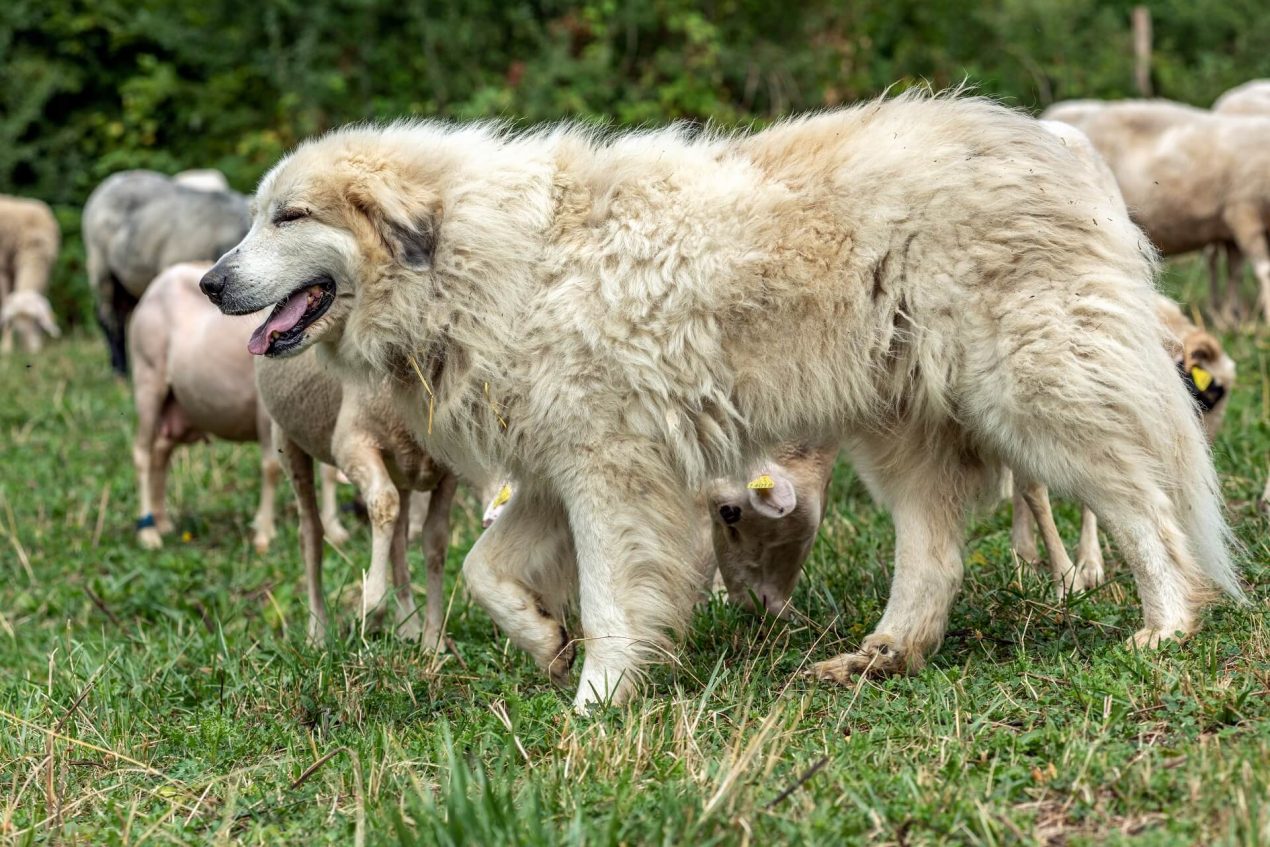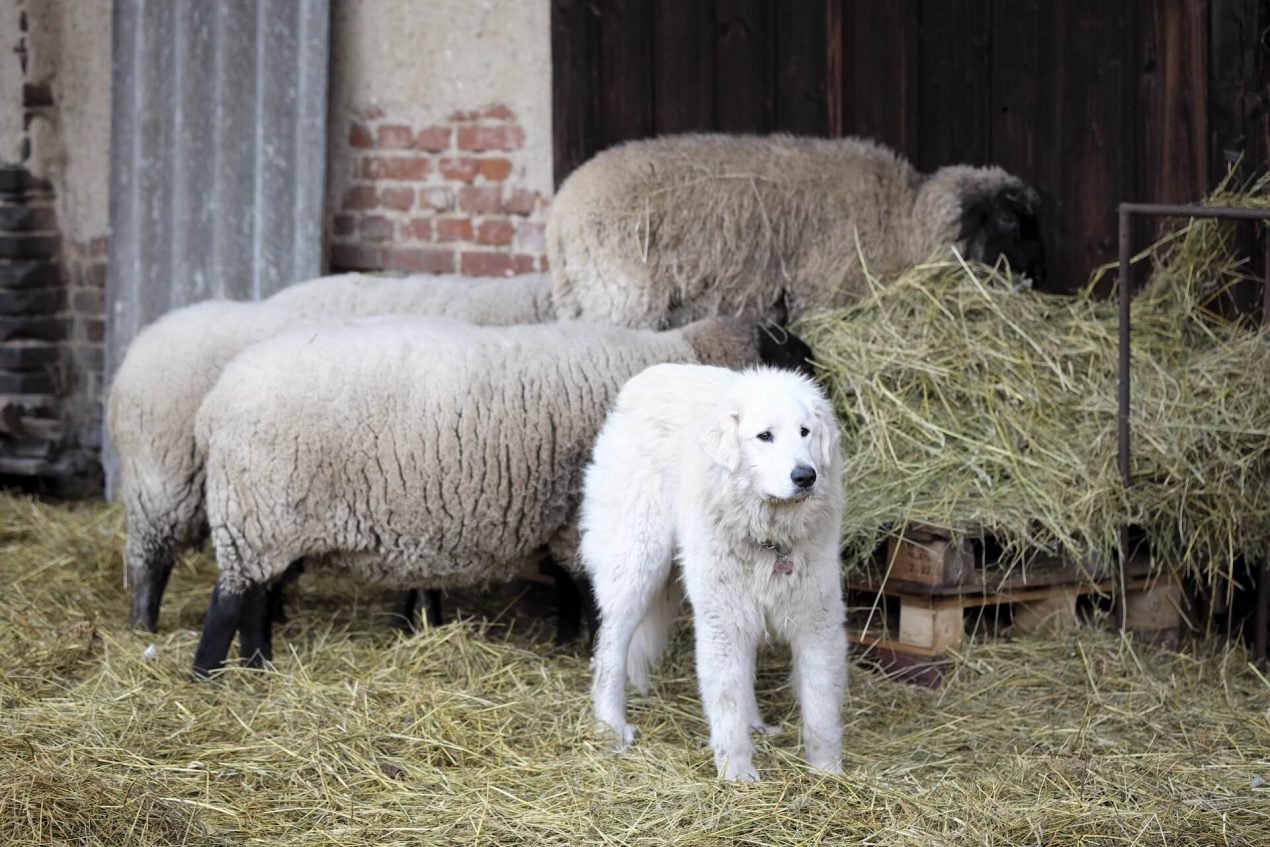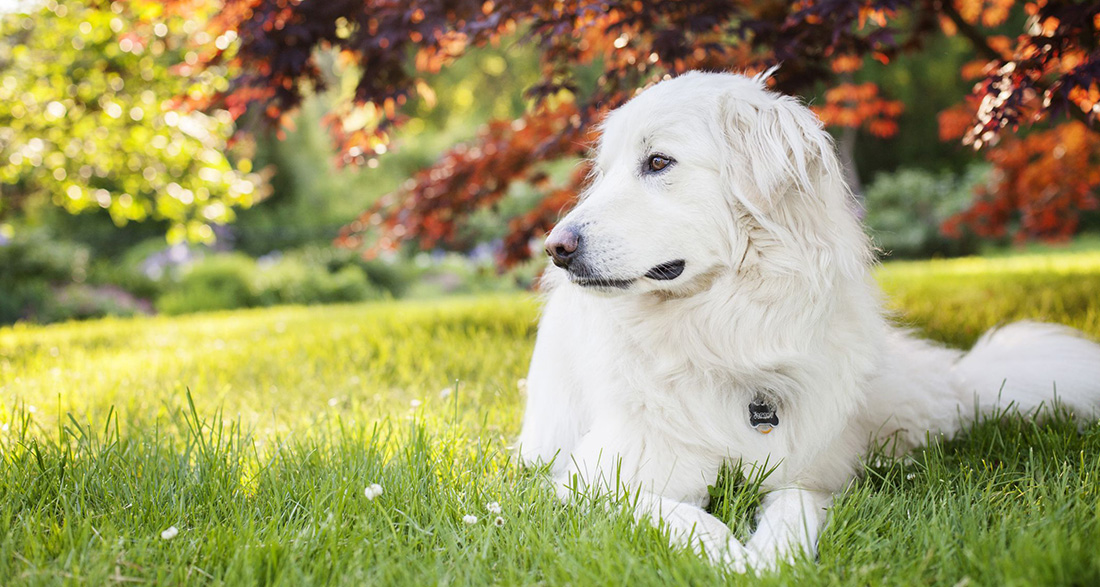The Great Pyrenees manages to combine opposing traits into a harmonious character. It is both a fearless protector and an affectionate teddy bear.
History of the Great Pyrenees
The Great Pyrenees is a French dog breed originally from the border mountains between Spain and France, known as the Pyrenees.
Their primary role was guarding the estate and protecting the herd. At times, Great Pyrenees dogs were also used as war dogs or a kind of pack animal.
The history of the Great Pyrenees unfolds chronologically:
- The existence of Great Pyrenees dogs is traced back to the Bronze Age.
- In the 15th century, Great Pyrenees dogs were employed to guard noble houses.
- By the 17th century, the Great Pyrenees became a status symbol and a companion animal.
- They participated in the first dog show in France. The first breed club was established in 1907.
- The breed’s standard was recognized by the Société Centrale Canine de France in 1923.
- By 1933, the breed had international representation and was acknowledged by the American Kennel Club.
- In 1955, the Fédération Cynologique Internationale recognized the breed.
- After nearly facing extinction in the early 20th century, interest in the breed revived in the 80s.
Genetically, the Great Pyrenees is presumed to have roots in the Hungarian Kuvasz and the Mastiff.
Interesting: Due to a lack of agreement between the Spanish and the French regarding a common breed description, the Great Pyrenees lives on as two separate breeds (the French Chien de Montagne des Pyrénées and the Spanish Mastín del Pirineo). Despite this division, individuals do not differ significantly due to their shared history.
Breed Overview
GROUP: Working
HEIGHT: 25 to 32 inches at the shoulder
WEIGHT: 100 to 150 pounds (males); 85 to 110 pounds (females)
TEMPERAMENT: Gentle, affectionate, patient, confident, strong-willed, fearless
COAT: Thick double coat
COAT COLOR: White, but may have markings of gray, tan, badger, or reddish-brown
HYPOALLERGENIC: No
LIFE SPAN: 10 to 12 years
Appearance
Upon first sight of the Great Pyrenees, its impressive size and strength are immediately apparent. Males typically stand between 70 and 80 cm, while females reach a height of 65 to 75 cm. Despite its size, the Great Pyrenees appears athletic and agile, far from being cumbersome or bulky. Instead, it exudes a kind of elegance.
A distinctive feature is its medium-length coat, dense and smooth, providing warmth in cool weather. Occasionally, a slight wave in the fur may be observed. Beneath the outer coat, the Great Pyrenees has a dense undercoat, offering protection against the elements. Coat maintenance is uncomplicated, and regular brushing keeps it in good condition.
Nature and Character
On one hand, the Great Pyrenees is a gentle teddy bear, enjoying close contact with its family and possessing a calm core.
On the other hand, it sometimes reveals its protective side. The Great Pyrenees courageously advocates for the well-being of the family, acting intuitively and making decisions independently. These instinctive behaviors stem from its former role in herd protection, requiring independence, sovereignty, and strong will.
While the Great Pyrenees forms a close bond with family members, including other pets, it defends its territory against those who do not belong.
| Affection Level | High |
| Friendliness | High |
| Kid-Friendly | High |
| Pet-Friendly | High |
| Exercise Needs | High |
| Playfulness | High |
| Energy Level | Medium |
| Trainability | Medium |
| Intelligence | Medium |
| Tendency to Bark | High |
| Amount of Shedding | High |

Acquiring a Great Pyrenees
In the US, fewer than 1,000 puppies are born each year. Compared to Labrador Retrievers, which produce up to 8,000 offspring annually, the Great Pyrenees is a genuine rarity. If interested in purchasing, it is advisable to contact the American Kennel Club. These organizations provide contact information for registered breeders, sorted by location.
Due to their rarity, sellers demand a high price of $1,000 to $4,000.
What should I consider when buying?
The acquisition of a dog is an irreversible decision and should be well thought out and based on solid ground.
By following the tips below, the likelihood of a positive buying experience increases:
- Acquire expertise and specific breed knowledge.
- Choose a reputable breeder, recognizable by the following: Documenting the litter photographically; Visiting the mother dog; Allowing insights into the breeding site; Answering your questions and asking proactive questions; Implementing health precautions; Not selling puppies at rock-bottom prices and without papers
- The Great Pyrenees should be purebred, as mixed-breed dogs may exhibit unwanted behavioral traits.

Development and Training of the Puppy
The Great Pyrenees, having worked as a livestock guardian dog often left to its own devices, remains an autonomous animal today. In the hands of a dedicated dog owner, it can still learn to align with human rules. However, achieving this requires perseverance, expertise, and diligence. This dog breed is not recommended for beginners due to its strong-willed nature. The core competencies of an ideal owner are flexibility, consistency, and self-assurance. Additionally, the owner should be knowledgeable and experienced.
Tip: Avoid using punishments and coercion, as these methods are not effective and may only result in the Great Pyrenees becoming unresponsive.
Despite these challenges, it has the potential to be an excellent family dog. However, it is crucial to socialize it deliberately. Attending a dog school can be very helpful, as the Great Pyrenees needs to develop a high threshold for stimuli and social competencies. If it cannot gain these experiences, it may struggle to adapt to the everyday life of a family dog.
How to Care for a Great Pyrenees
The Great Pyrenees is not a typical house or family pet. Proper training, however, provides a framework for acquiring the necessary social skills.
When the Great Pyrenees has been socialized early, it copes well with human proximity and requires it. If children are part of the family, they also become part of its close circle. However, it is essential to respect its need for rest from all family members.
Since this dog breed can exert immense force, it is unsuitable for seniors and should not be left alone with physically impaired individuals and children.
Special attention is needed in social situations as it is very aloof towards strangers.
According to its disposition, the Great Pyrenees seeks to establish territorial boundaries and defend its territory against intruders. As it cannot fully express this inclination in an apartment, it needs a limited outdoor space. A courtyard or a fenced garden would be ideal. The enclosure must be secure to prevent it from escaping, as its territorial understanding extends not only to its movement area but the entire visible area.
Activities
While the Great Pyrenees is an active dog, it is not a high-performance animal.
It does not enjoy fast movements, as seen in activities like agility or dog dancing.
Nevertheless, it appreciates extended walks and spending time outdoors.
To fully harness your Great Pyrenees’s potential, you can train it as a working dog (such as a tracking, avalanche search, or rescue dog) or introduce it to pulling activities. Additionally, it enjoys accompanying on hikes and being a companion to a horse.

Health and Genetic Diseases
The health of your Great Pyrenees is a crucial topic that deserves serious attention. Although Great Pyrenees are considered a robust and healthy breed, there are some health concerns and potential genetic diseases you should be aware of.
Ear Problems: One challenge you might encounter involves the ears of the Great Pyrenees. Regularly cleaning the ears can prevent the buildup of secretions, which can become inflamed, disrupt the dog’s sense of balance, and impair hearing.
Hip Dysplasia: Like many large dogs, Great Pyrenees are at risk of hip dysplasia, an inherited disease affecting the hip joints and leading to pain and restricted movement.
Extra Toes: The Great Pyrenees has additional toes on its hind legs. While not necessarily a disease, it is a characteristic that may require special care to avoid problems.
Although few genetic diseases are known in Great Pyrenees, it is always advisable to schedule regular veterinary check-ups to monitor your Great Pyrenees’s health and ensure it leads a long, healthy, and happy life.
Caring for a Great Pyrenees
Caring for this dog breed is not significantly different from caring for other dog breeds:
Fur: The coat of the Great Pyrenees quickly mats (especially on the legs and ears). Prevent knot formation with regular brushing. Some individuals may need coat care twice a week, while others may find a weekly routine sufficient. Observe how your dog’s coat behaves and adjust the grooming interval accordingly. Note: During shedding seasons, intervals may be shorter than usual.
Ears: Regular ear cleaning prevents the buildup of secretions, which can become inflamed, disrupt the dog’s sense of balance, and impair hearing.
Claws: The Great Pyrenees has additional toes on its hind legs (so-called dewclaws). The horn layer of the other claws is worn down upon contact with the ground. Since dewclaws do not touch the ground, you must regularly trim the claws, as otherwise, painful injuries (such as ingrowth or snagging) may occur.
Additionally, preventive examinations and parasite protection are necessary.
As Great Pyrenees dogs are not overbred fashionable dogs, the risk of hereditary diseases is very low. Nevertheless, the parent animals should have tested negative for hip and elbow dysplasia!
You should feed your Great Pyrenees high-quality food.
Whether it is raw, wet, or dry food does not matter, as long as the composition:
- is based on high-quality meat and
- provides the dog with all the nutrients it needs (considering activity level, growth phases/age, intolerances, and illnesses).
Interesting and Worth Knowing
Amazing facts about the Great Pyrenees – did you know?
- The Great Pyrenees is a large dog. A litter size of seven to eight puppies is quite normal. In contrast, the Great Pyrenees gives birth to an astonishing number of puppies (up to 15 per litter)!
- The local population also calls the Great Pyrenees “Patou.”
- The Great Pyrenees has a criminal past. In times past, people loaded it with smuggled goods and had it transport them over difficult paths.
Do you have a Great Pyrenees, or are you planning to get one? Tell me in the comments what makes it special in your opinion!


